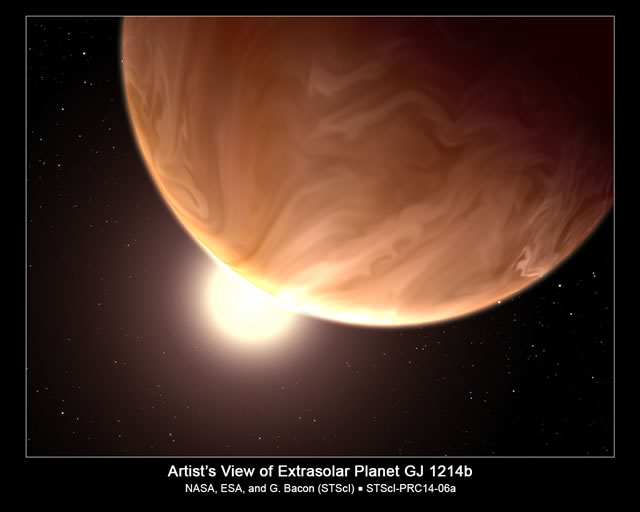
GJ 1214b. Credit: NASA, ESA, & G. Bacon/STScI, STScI-PRC14-06
Pare che elaborare le previsioni del tempo sull’esopianeta GJ 1214b sia un lavoro piuttosto facile. Previsioni per oggi: nuvoloso. Domani: coperto. Previsione estesa: ancora più nubi. Un team di scienziati guidato da ricercatori del Dipartimento di Astronomia e Astrofisica dell’Università di Chicago hanno per la prima volta definitivamente caratterizzato l’atmosfera di un pianeta classificato come “super-Terra” in orbita intorno a un’altra stella.
Il pianeta esaminato, conosciuto come GJ1214b, è classificato come super-Terra poichè la sua massa è intermedia tra quelle della Terra e quella di Nettuno. Recenti ricerche di pianeti intorno ad altre stelle (pianeti extrasolari) hanno dimostrato che le super-Terre come GJ 1214b sono tra il tipo più comune di pianeti nella nostra galassia, la Via Lattea. Poiché non esistono pianeti nel nostro Sistema Solare, la natura fisica delle super-Terre è in gran parte sconosciuta. Precedenti studi riguardanti GJ 1214b hanno prodotto due possibili interpretazioni dell’atmosfera del pianeta. L’atmosfera potrebbe consistere interamente di vapore acqueo o di qualche altro tipo di molecola pesante, o potrebbe contenere nuvole ad alta quota che impediscono l’osservazione di ciò che si trova sotto.
Weather forecasters on exoplanet GJ 1214b would have an easy job. Today’s forecast: cloudy. Tomorrow: overcast. Extended outlook: more clouds. A team of scientists led by researchers in the Department of Astronomy and Astrophysics at the University of Chicago report they have definitively characterized the atmosphere of a super-Earth class planet orbiting another star for the first time.
The scrutinized planet, which is known as GJ1214b, is classified as a super-Earth type planet because its mass is intermediate between those of Earth and Neptune. Recent searches for planets around other stars (“exoplanets”) have shown that super-Earths like GJ 1214b are among the most common type of planets in the Milky Way galaxy. Because no such planets exist in our Solar System, the physical nature of super-Earths is largely unknown. Previous studies of GJ 1214b yielded two possible interpretations of the planet’s atmosphere. Its atmosphere could consist entirely of water vapor or some other type of heavy molecule, or it could contain high-altitude clouds that prevent the observation of what lies underneath.
Source/Continue reading → Phys.org
Leggi anche/Read also: Hubble:





















